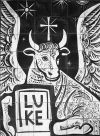
The Gospel of Luke
He has been raised: Luke 24,1-12
All four Gospel accounts of Easter morning are broadly similar: women coming to the tomb and not finding the body of Jesus. In the three Synoptic Gospels, there are angels to announce what has happened. What is distinctive about Luke is that the emphasis is not on the empty tomb but rather on the proclamation of the Easter Gospel (24,5-8). This begins the process of eye-witnesses becoming ministers of the word (see 1,2) which leads on into the Acts of the Apostles.
All the Gospels have variations on the time of the visit. The light of dawn is also the light of the resurrection. So early dawn (24,1) prepares for the message of verse 5. The stress on spices both at burial (23,56) and in the morning indicates that Jesus was truly dead.
Verses 2 and 3 then speak of the women's arrival at the tomb and the stone rolled away. Jesus is called "Lord" quite frequently as we have seen. Here it has its full meaning of the risen Lord. Not all manuscripts include "of the Lord Jesus". Thus it is found in a footnote in the NRSV despite the strong support for the phrase.
In verse 4, the dazzling clothes of the men is an indication of their divine status.
Their message in verses 5-7 is similar in wording to the first prediction of his fate by Jesus (9,22). This detailed proclamation is unique to Luke.
In verses 6 & 8, there is a notable stress on memory. The key here is that memory is active in the present, not just remembering past events (22,19).
The women then become the first missionaries, the first to announce the resurrection (verse 9).
Only at this point in verse 10 are they named. Since 22,49 they have been called the women who followed Jesus from Galilee. Two of the three women named are also found in the other Gospels. The naming here may be to stress their reliability as witnesses. Though as so often this witness is received as an idle tale (verse 11).
One man, Peter, did though hear the message and went to explore further, verse 12. He is left marvelling much like the shepherds visiting Bethleham to see the new born Jesus (2,18). Nontheless, no conclusion is drawn, this first resurrection scene is left open ended./p>
Let us now return to the main page
